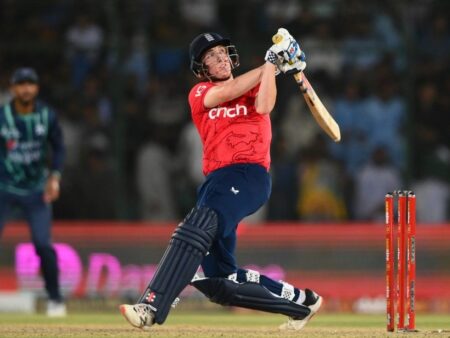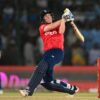A specific moment on April 30, 2023, when Matheesha Pathirana bowled a slower ball instead of a yorker to Sikandar Raza, who needed three runs off the last ball, highlights a crucial question in T20 cricket: Which delivery should be bowled when?
This decision isn`t made in isolation; it`s part of a larger strategy. Bowlers must plan how to best utilize their primary and secondary options throughout an over. This leads to the broader concept of over construction.
While bowlers have different styles, data reveals trends, especially among pacers. Pathirana`s performance in recent IPL seasons provides a case study on effective tactics and where his approach might have faltered.
Matheesha Pathirana – A Case Study
The middle overs (12-16) are particularly insightful for analyzing fast bowlers` over construction. This phase sees more pacers than earlier middle overs and combines higher attack rates from the innings` end with less unpredictable outcomes than death overs.
Pathirana`s economy rate in the middle overs significantly worsened from just over seven in IPL 2024 to 10.32 this year. His bowling average also rose sharply from 10.22 to 67.66.
His main deliveries are undoubtedly the yorker, bouncer, and slower ball. He`s bowling bouncers at the same frequency (29%) and his slower balls are still economical (under five). His yorker accuracy has even improved by 17%.
The change lies in how he constructs his overs. In 2024, nearly 45% of his middle-over deliveries were conventional pace balls, not variations. This dropped to about 30% this year, suggesting a reduced reliance on his stock delivery which previously served him well.
This season, Pathirana has used his wicket-taking variations more frequently and earlier in the over. The chance of him starting an over with a length ball has almost halved, while starting with a yorker has nearly tripled. Essentially, he`s using his variations in the first half of the over, making his strategy predictable over six balls.
While slower ball and bouncer usage is consistent, the bouncer`s effectiveness has dropped dramatically, from an economy of 4.15 last year to 7.5. Again, over construction is key. Comparing him to top bowlers like Arshdeep Singh, Jasprit Bumrah, and Harshal Patel in the 12-16 over phase is revealing.
Unlike these bowlers who often use the bouncer mid-over, Pathirana`s probability of bowling a bouncer increases as the over progresses, using it more than twice as often in the second half. A similar pattern is seen with his yorkers.
This suggests that the yorker is best used as a delivery to finish the over. Top IPL bowlers like Bumrah, Arshdeep, and Harshal use it this way, with the highest probability on the final ball, a trend common among successful fast bowlers.
Pathirana`s economy rates show this: 8.3 when starting with a bouncer vs 6.9 otherwise; 7.76 starting with a slower ball vs 6.66; 8.12 starting with a yorker vs 6.73. Crucially, it`s 6.69 when starting with a length ball vs 8.31 otherwise.
Even considering that bowlers might use variations when under pressure (leading to higher economy), a clear pattern emerges. Batters are capitalizing when they expect an early yorker from Pathirana. An early boundary puts the bowler on the defensive, forcing predictable lengths for the rest of the over.
Shifting back to using the length ball as the primary delivery, with yorkers and bouncers as surprise options, would improve his numbers. Even if the initial length ball goes for runs, he retains the option to use any of his variations later.
Pathirana is unique due to his action and pace, giving him more flexibility. However, he may not yet have the accuracy and experience to effectively use variations as stock balls.
Generally, pace bowlers benefit from starting overs with stock balls, using attacking options mid-over, and defensive options to finish. While skill sets vary, bowlers should employ deliveries based on situation and conditions.
Variance is also vital. While not guaranteed, bowlers using more deliveries from their toolkit tend to be more successful. Since 2022, Prasidh Krishna`s economy is better in overs where he uses all three variations (yorker, bouncer, slower ball) compared to when he doesn`t. This trend holds for many other successful pacers.
In modern T20, the batter often holds the advantage, needing to take risks. The bowler`s role is less about getting wickets and more about preventing scoring opportunities and forcing errors. Over construction should be built around this principle.
Spin Strategy – Away Spin and Pace Variation
Spinners have fewer variations than pacers but can still manipulate turn direction, flight, speed, and release points. Turn direction, particularly away spin, is a key starting point in the modern game.
In IPL 2025, few right-handers facing away spin average over 40 with a strike rate above 150. Similarly, only a few left-handers are highly successful against away spin.
This makes the stock ball turning away from the batter a significant advantage for most spinners, reflected in their over construction.
Among spinners regularly turning the ball both ways against right-handers, only Sunil Narine and Noor Ahmad use less away spin than in-spin, largely succeeding due to their overall control or wicket-taking ability respectively.
Against left-handers, only Rashid Khan and Ravi Bishnoi use less away spin. Interestingly, Bishnoi`s googlies (in-spin to lefties), once a strength, are now expensive.
The data shows the economy of away-going balls is crucial for spinners` success and strategy.
An over construction strategy combining four away-spinners and two in-spinners has proven effective for bowlers like Noor Ahmad (against lefties) and Suyash Sharma (against righties).
Finger-spinners are adapting. Left-arm spinners are bowling more balls turning away from left-handers this season compared to previous years. Some, like Krunal Pandya, are also using the bouncer more frequently than the average spinner.
However, Krunal`s variance isn`t primarily about the bouncer but pace variation; he has the highest standard deviation of release speeds among finger-spinners. Other successful spinners like Sai Kishore, Varun Chakaravarthy, and Riyan Parag also vary their pace well.
While quick wrist-spin may be the future, varying pace, even slowing it down, is effective in IPL 2025. Spinners may not have emphasized over construction as much as pacers previously, but as they take on more death-bowling roles on flatter tracks against powerful hitters, they must focus on optimizing every delivery within an over.
30 अप्रैल 2023 को एक खास पल आया, जब सिकंदर रजा को आखिरी गेंद पर तीन रन चाहिए थे और मथीशा पथिराना ने यॉर्कर के बजाय धीमी गेंद फेंकी। यह घटना टी20 क्रिकेट में एक महत्वपूर्ण सवाल उठाती है: कौन सी गेंद कब फेंकनी चाहिए?
यह फैसला सिर्फ उस क्षण का नहीं होता; यह एक बड़ी रणनीति का हिस्सा है। गेंदबाजों को यह योजना बनानी होती है कि वे अपने मुख्य और वैकल्पिक विकल्पों का उपयोग ओवर में कैसे करें। यही ओवर निर्माण का मूल विचार है।
हालांकि हर गेंदबाज का तरीका अलग होता है, डेटा कुछ रुझान दिखाता है, खासकर तेज गेंदबाजों में। पथिराना का प्रदर्शन इस बात का उदाहरण है कि टी20 गेंदबाजों के लिए क्या कारगर है और श्रीलंका के इस गेंदबाज की धार इस आईपीएल सीजन में क्यों कम हुई है।
मथीशा पथिराना – एक केस स्टडी
मध्य ओवर (12-16) तेज गेंदबाजों के ओवर निर्माण का विश्लेषण करने के लिए सबसे उपयोगी चरण हैं। इस चरण में शुरुआती मध्य ओवरों (7-11) की तुलना में अधिक तेज गेंदबाज गेंदबाजी करते हैं। इसमें पारी के आखिरी चरण की उच्च आक्रमण दर शामिल होती है, लेकिन डेथ ओवरों के बहुत ज्यादा अप्रत्याशित परिणाम नहीं होते, इसलिए यह एक तरह से दोनों दुनियाओं का सबसे अच्छा हिस्सा है।
आईपीएल 2024 में मध्य ओवरों में पथिराना की इकोनॉमी रेट सात से थोड़ी ऊपर थी। इस साल यह बढ़कर 10.32 हो गई है। वहीं, उनका गेंदबाजी औसत 10.22 से बढ़कर 67.66 हो गया है।
इसमें कोई शक नहीं कि पथिराना के मुख्य हथियार यॉर्कर, बाउंसर और धीमी गेंद हैं। वह पिछले साल की तरह ही बाउंसर फेंक रहे हैं (29%), और उनकी धीमी गेंदों पर इकोनॉमी रेट अभी भी पांच से कम है। उनकी यॉर्कर की सटीकता वास्तव में बढ़ी है – वह 2024 की तुलना में 17% अधिक बार यॉर्कर सही जगह पर फेंक रहे हैं।
बदलाव ओवर निर्माण में है। जबकि पथिराना के पास कई तरह की गेंदें हैं, उन्हें स्टॉक बॉल (मुख्य गेंद) का विकल्प नहीं समझना चाहिए। 2024 में, मध्य ओवरों में उनकी लगभग 45% गेंदें यॉर्कर, धीमी गेंद या बाउंसर नहीं थीं, यह आंकड़ा इस साल घटकर लगभग 30% हो गया है। उनकी पारंपरिक तेज गेंदबाजी पर निर्भरता उनके लिए फायदेमंद रही थी।
हालांकि, चल रहे आईपीएल में, पथिराना ने पारंपरिक तरीके से हटकर अपनी विकेट लेने वाली गेंदों का उपयोग अधिक बार और अलग-अलग समय पर किया है। ओवर की शुरुआत लेंथ गेंद से करने की उनकी संभावना लगभग आधी हो गई है, जबकि यॉर्कर से शुरुआत करने की संभावना लगभग तीन गुना बढ़ गई है। सीधे शब्दों में कहें तो, यह स्लिंगर प्रत्येक ओवर के पहले भाग में अपनी विविधताएं इस्तेमाल कर रहा है, जिससे वह छह (और कभी-कभी 10) गेंदों में बेहद अनुमानित हो गया है।
पथिराना की धीमी गेंद और बाउंसर का उपयोग एक समान रहा है, लेकिन बाउंसर के प्रदर्शन में भारी अंतर आया है। पिछले साल 4.15 की इकोनॉमी रेट से जाने वाले बाउंसर अब 7.5 की रेट से जा रहे हैं। फिर से, इसका कारण ओवर निर्माण में है। 12-16 ओवर के चरण पर जोर देते हुए, 22 वर्षीय इस गेंदबाज की तुलना लीग के कुछ बेहतरीन गेंदबाजों से करना स्वाभाविक है।
अर्शदीप सिंह, जसप्रीत बुमराह और हर्षल पटेल के विपरीत, ओवर बढ़ने के साथ पथिराना के बाउंसर फेंकने की संभावना बढ़ जाती है। वह ओवर के दूसरे हिस्से में इसे दोगुने से भी ज्यादा बार फेंकते हैं, जबकि बाकी गेंदबाज इसे ओवर के बीच में हथियार के तौर पर इस्तेमाल करते हैं। यॉर्कर के साथ भी इसी तरह का हानिकारक पैटर्न देखा जा सकता है।
यहां मुख्य निष्कर्ष यह है कि यॉर्कर एक ऐसी गेंद है जो ओवर को समाप्त करती है। लीग के सर्वश्रेष्ठ यॉर्कर फेंकने वाले गेंदबाज, जिनमें बुमराह, अर्शदीप और हर्षल शामिल हैं, इसे इसी तरह इस्तेमाल करते हैं। आखिरी गेंद पर यॉर्कर फेंकने की उनकी संभावना सबसे अधिक होती है, और यह ट्रेंड आईपीएल के अधिकांश सफल तेज गेंदबाजों के लिए सही है।
पथिराना की इकोनॉमी रेट से यह साफ पता चलता है: जब वह बाउंसर से शुरुआत करते हैं तो यह 8.3 होती है, और जब नहीं करते तो 6.9। धीमी गेंद से शुरुआत करने पर यह 7.76 होती है, और जब नहीं करते तो 6.66। यॉर्कर से शुरुआत करने पर यह 8.12 होती है, और जब नहीं करते तो 6.73। सबसे महत्वपूर्ण बात यह है कि जब वह लेंथ गेंद से शुरुआत करते हैं तो यह 6.69 होती है, और जब नहीं करते तो 8.31।
यह मानते हुए भी कि पथिराना दबाव वाले ओवरों में अपनी विविधताओं का सहारा ले सकते हैं, जिससे अधिक रन बनते हैं, एक स्पष्ट पैटर्न सामने आता है। बल्लेबाज उस दूसरी स्थिति का फायदा उठा रहे हैं, जहां वे पथिराना से शुरुआत में यॉर्कर की उम्मीद करते हैं। उस गेंद पर चौका या छक्का गेंदबाज पर तुरंत दबाव डाल देता है, जिसे अब लेंथ या शॉर्ट गेंद फेंकनी पड़ती है। किसी भी तरह से, ओवर के बाकी हिस्से में, वह अनुमानित और गंभीर दबाव में रहेगा।
पहली स्थिति में बदलाव, जहां वह जरूरत पड़ने पर यॉर्कर और बाउंसर को सरप्राइज विकल्प के रूप में इस्तेमाल कर सकता है, उसके आंकड़ों को सुधारने में बहुत मदद करेगा। भले ही उसकी शुरुआती लेंथ गेंद पर रन पड़ें, उसके पास हमेशा पेस कम करने और/या अपनी तीन विविधताओं में से किसी का भी उपयोग करने का विकल्प होगा।
एक तरह से, पथिराना की तुलना अन्य तेज गेंदबाजों से करना अनुचित है। श्रीलंका के इस गेंदबाज के बारे में सब कुछ अनोखा है – उनका स्लिंगी एक्शन और कम रिलीज पॉइंट, पुरानी गेंद से मिलने वाला बेजोड़ स्विंग, उनकी तेज गति, आदि। लेकिन जबकि उनके पास गलती करने की अधिक गुंजाइश और लचीलापन है, वह अभी भी अपनी विविधताओं को स्टॉक बॉल के रूप में उपयोग करने के लिए पर्याप्त सटीक और अनुभवी नहीं हैं।
एक सामान्य सिद्धांत के रूप में, तेज गेंदबाजों के लिए यह समझदारी है कि वे ओवर की शुरुआत में अपनी स्टॉक बॉल का उपयोग करें, ओवर के मध्य में अपने मुख्य आक्रमण विकल्पों का, और ओवर को समाप्त करने के लिए अपने मुख्य रक्षात्मक विकल्पों का। हर गेंदबाज के पास पथिराना जैसा विविध और अनोखा कौशल सेट नहीं हो सकता है, लेकिन उनके पास निश्चित रूप से गेंदों का एक सेट होगा जिसे वे स्थिति और परिस्थितियों के अनुसार इस्तेमाल करते हैं।
विविधता (Variance) ओवर निर्माण का एक और महत्वपूर्ण घटक है। इस बात की कोई गारंटी नहीं है कि एक गेंदबाज जो अपनी सभी गेंदों का उपयोग करता है, वह अधिक सफल होगा, लेकिन ऐसे कई मामले हैं जहां ऐसा प्रतीत होता है। 2022 से, प्रसिद्ध कृष्णा की इकोनॉमी रेट उन ओवरों में 8.82 है जहां वह तीनों विविधताओं – यॉर्कर, बाउंसर, धीमी गेंद – का प्रयास करते हैं, और जब नहीं करते तो 11.12। उच्च-विविधता वाले ओवरों में बेहतर इकोनॉमी रेट का ट्रेंड अर्शदीप सिंह, मोहम्मद सिराज, पैट कमिंस, मोहम्मद शमी, जोश हेजलवुड, खलील अहमद, हर्षल पटेल और कई अन्य लोगों के लिए भी सही है।
आधुनिक टी20 में, खेल लगभग हमेशा बल्लेबाज के हाथ में होता है, जिसे या तो सफल जोखिम उठाना होता है या आउट हो जाना होता है। गेंदबाज का काम शायद ही कभी बल्लेबाज को आउट करना होता है – आमतौर पर, यह रन बनाने के अवसर को रोकना और गलती करवाना होता है। ओवर का निर्माण इसी मूलभूत अवधारणा के इर्द-गिर्द संरचित होना चाहिए।
स्पिन रणनीति – अवे स्पिन और गति में बदलाव
स्पिन गेंदबाजों के पास तेज गेंदबाजों जितनी अनोखी गेंदें नहीं हो सकती हैं, लेकिन उनके पास अभी भी काम करने के लिए बहुत कुछ है। जबकि वे लेंथ के साथ तेज गेंदबाजों की तरह प्रयोग नहीं कर सकते हैं, टर्न की दिशा, फ्लाइट, गति, गेंद पर घूमने की दिशा और रिलीज पॉइंट कुछ ऐसे कारक हैं जिनके साथ वे खेल सकते हैं। टर्न की दिशा, खासकर आधुनिक युग में, ओवर निर्माण के लिए सबसे स्वाभाविक शुरुआती कदम है।
आईपीएल 2025 में 26 ऐसे दाएं हाथ के बल्लेबाज हैं जिन्होंने 30 से अधिक अवे स्पिन गेंदों का सामना किया है, जिनमें से केवल छह का औसत 40 से अधिक है और स्ट्राइक रेट 150 से ऊपर है। ये हैं सूर्यकुमार यादव, श्रेयस अय्यर, जोस बटलर, आयुष बडोनी, एडेन मार्करम और शशांक सिंह। 14 बाएं हाथ के बल्लेबाजों में से, केवल तीन ऐसा करते हैं – निकोलस पूरन, रिंकू सिंह और रियान रिक्ले्टन।
इसलिए अधिकांश स्पिनरों के लिए, बल्लेबाज से दूर जाने वाली स्टॉक बॉल एक बड़ा फायदा है। यह उनके ओवर निर्माण के तरीकों में झलकता है।
आईपीएल 2025 में 11 स्पिनरों ने दाएं हाथ के बल्लेबाजों के खिलाफ नियमित रूप से (प्रत्येक प्रकार की कम से कम 12 गेंदें) गेंद को दोनों तरह से घुमाया है। इनमें से, सुनील नरेन (39.5%) और नूर अहमद (41.7%) ही ऐसे हैं जो इन-स्पिन की तुलना में कम अवे-स्पिन का उपयोग करते हैं। वे ऐसा कर सकते हैं – जबकि नरेन की सीजन में इकोनॉमी रेट सिर्फ 7.53 है, नूर ने पहले ही आठ से थोड़ी ऊपर की औसत से 20 विकेट ले लिए हैं।
इसी तरह के फिल्टर का उपयोग करके, प्रत्येक प्रकार की कम से कम 12 गेंदों के साथ, आईपीएल 2025 में 10 स्पिनरों ने बाएं हाथ के बल्लेबाजों के खिलाफ गेंद को दोनों तरह से घुमाया है। राशिद खान (28.7%) और रवि बिश्नोई (22.8%) ही ऐसे हैं जो इन-स्पिन की तुलना में कम अवे-स्पिन का उपयोग करते हैं। दिलचस्प बात यह है कि बिश्नोई की बाएं हाथ के बल्लेबाजों को फेंकी गई गुगली, जो कुछ साल पहले उनकी सबसे बड़ी ताकत में से एक थी, अब 12.86 की इकोनॉमी रेट से पिट रही है।
डेटा से यह स्पष्ट है कि दूर जाने वाली गेंदों की इकोनॉमी रेट न केवल स्पिनरों के संचालन के तरीके में बल्कि उनकी सफलता की डिग्री में भी एक निर्णायक कारक है।
ओवर निर्माण के दृष्टिकोण से, चार अवे-स्पिनर और दो इन-स्पिनर का संयोजन अच्छी तरह से काम करता है। बाएं हाथ के बल्लेबाजों के खिलाफ नूर अहमद और दाएं हाथ के बल्लेबाजों के खिलाफ सुयश शर्मा उन लोगों में से हैं जिन्होंने इस दृष्टिकोण का उपयोग करते हुए उच्च सफलता दर हासिल की है।
इस अवे-स्पिन ट्रेंड के अनुकूल होने के लिए फिंगर-स्पिनर क्या कर सकते हैं? आईपीएल 2025 के 60 से कम मैचों में, बाएं हाथ के स्पिनरों ने 37 गेंदें ऐसी फेंकी हैं जो बाएं हाथ के बल्लेबाजों से दूर घूमी हैं। 2022 से पिछले सभी पूरे हुए आईपीएल सीजन में 30 से कम (2022 में 17, 2023 में 29 और 2024 में 24) गेंदें फेंकी गई थीं। साई किशोर, कुमार कार्तिकेय और अभिषेक शर्मा उन लोगों में से हैं जिन्होंने बाएं हाथ के बल्लेबाजों को दूर जाने वाली गेंदें फेंकी हैं।
अन्य, जैसे क्रुणाल पंड्या, ने बाउंसर का सहारा लिया है। क्रुणाल ने 10 मीटर से छोटी 11 गेंदें फेंकी हैं, जिनमें दो विकेट शामिल हैं, और उनकी 25.7% गेंदें 7 मीटर से छोटी रही हैं। संदर्भ के लिए, आईपीएल 2025 में औसत स्पिनर ने केवल 13.7% गेंदें 7 मीटर से छोटी फेंकी हैं।
लेकिन बाउंसर क्रुणाल की विविधता और ओवर निर्माण की कुंजी नहीं है – गति है। वास्तव में, लीग के सभी फिंगर-स्पिनरों में उनकी रिलीज गति का मानक विचलन सबसे अधिक है। अन्य जिन्होंने अच्छा प्रदर्शन किया है, जैसे साई किशोर, वरुण चक्रवर्ती और रियान पराग, ने भी अपनी गति को अच्छी तरह से बदला है।
टी20 स्पिन गेंदबाजी का भविष्य शायद तेज कलाई स्पिन में है, लेकिन कभी-कभी गति कम करना आईपीएल 2025 में अविश्वसनीय रूप से प्रभावी साबित हुआ है। अब तक, स्पिनरों को ओवर निर्माण के बारे में शायद ज्यादा नहीं सोचना पड़ा, खासकर अपने तेज समकक्षों की तुलना में। लेकिन जैसे-जैसे वे डेथ-बॉलिंग की अधिक जिम्मेदारी लेंगे और सपाट पिचों और अधिक शक्तिशाली बल्लेबाजों का सामना करेंगे, उन्हें अपने नियंत्रण में हर एक पहलू पर जोर देना होगा।







